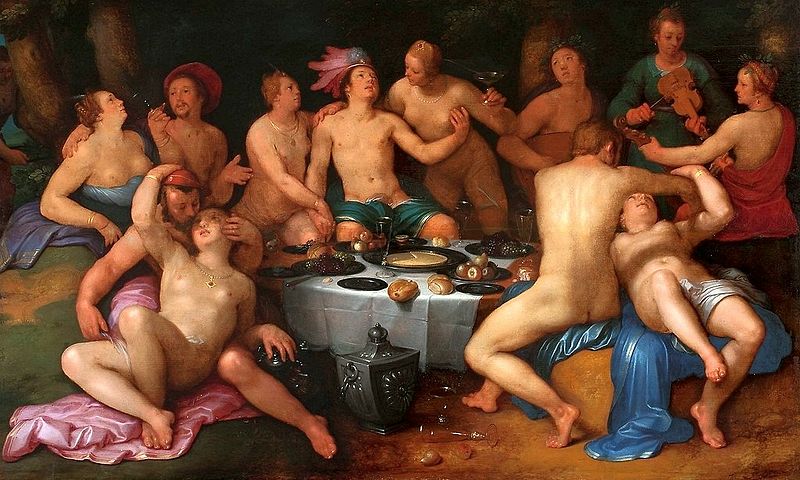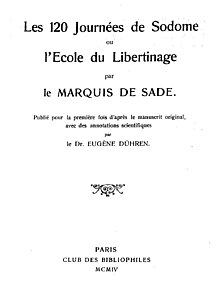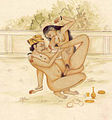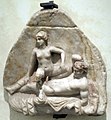Portal:Erotica and pornography
Introduction

Pornography (colloquially known as porn or porno) has been defined as sexual subject material such as a picture, video, text, or audio that is intended for sexual arousal. Made for consumption by adults, pornography depictions have evolved from cave paintings, some forty millennia ago, to virtual reality presentations. A general distinction of adult content is made classifying it as pornography or erotica.
The oldest artifacts considered pornographic were discovered in Germany in 2008 and are dated to be at least 35,000 years old. Throughout the history of erotic depictions, various people made attempts to suppress them under obscenity laws, censor, or make them illegal. Such grounds and even the definition of pornography have differed in various historical, cultural, and national contexts. The Indian Sanskrit text Kama Sutra (3rd century CE) contained prose, poetry, and illustrations regarding sexual behavior, and the book was celebrated; while the British English text Fanny Hill (1748), considered "the first original English prose pornography," has been one of the most prosecuted and banned books. In the late 19th century, a film by Thomas Edison that depicted a kiss was denounced as obscene in the United States, whereas Eugène Pirou's 1896 film Bedtime for the Bride was received very favorably in France. Starting from the mid-twentieth century on, societal attitudes towards sexuality became more lenient in the Western world where legal definitions of obscenity were made limited. In 1969, Blue Movie by Andy Warhol became the first film to depict unsimulated sex that received a wide theatrical release in the United States. This was followed by the "Golden Age of Porn" (1969–1984). The introduction of home video and the World Wide Web in the late 20th century led to global growth in the pornography business. Beginning in the 21st century, greater access to the Internet and affordable smartphones made pornography more mainstream. (Full article...)
Erotica is art, literature or photography that deals substantively with subject matter that is erotic, sexually stimulating or sexually arousing. Some critics regard pornography as a type of erotica, but many consider it to be different. Erotic art may use any artistic form to depict erotic content, including painting, sculpture, drama, film or music. Erotic literature and erotic photography have become genres in their own right. Erotica also exists in a number of subgenres including gay, lesbian, women's, monster, tentacle erotica and bondage erotica.
The term erotica is derived from the feminine form of the ancient Greek adjective: ἐρωτικός (erōtikós), from ἔρως (érōs)—words used to indicate lust, and sexual love. (Full article...)
Selected article

Pornographic magazines or erotic magazines, sometimes known as adult magazines or sex magazines, are magazines that contain content of an explicitly sexual nature. Publications of this kind may contain images of attractive naked subjects, as is the case in softcore pornography, and, in the usual case of hardcore pornography, depictions of masturbation, oral, manual, vaginal, or anal sex.
They primarily serve to stimulate sexual arousal and are often used as an aid to masturbation. Some magazines are general in their content, while others may be more specific and focus on a particular pornographic niche, part of the anatomy, or model characteristics. Examples include Asian Babes which focuses on Asian women, or Leg Show which concentrates on women's legs. Well-known adult magazines include Playboy, Penthouse, Playgirl, and Hustler. Magazines may also carry articles on topics including cars, humor, science, computers, culture, and politics. With the continued progression of print media to digital, retailers have also had to adapt. Software such as Apple's discontinued Newsstand enabled the downloading and displaying of digital versions of magazines but did not allow pornographic material. However, there are specific digital newsstands for pornographic magazines. (Full article...)
Selected work of erotic literature
The 120 Days of Sodom, or the School of Libertinage (French: Les 120 Journées de Sodome ou l'école du libertinage) is an unfinished novel by the French writer and nobleman Donatien Alphonse François, Marquis de Sade, written in 1785 and published in 1904 after its manuscript was rediscovered. It describes the activities of four wealthy libertine Frenchmen who spend four months seeking the ultimate sexual gratification through orgies, sealing themselves in an inaccessible castle in the heart of the Black Forest with 12 accomplices, 20 designated victims and 10 servants. Four aging prostitutes relate stories of their most memorable clients whose sexual practices involved 600 "passions" including coprophilia, necrophilia, bestiality, incest, rape, and child sexual abuse. The stories inspire the libertines to engage in acts of increasing violence leading to the torture and murder of their victims, most of whom are adolescents and young women.
The novel only survives in draft form. Its introduction and first part were written according to Sade's detailed plan, but the subsequent three parts are mostly in the form of notes. Sade wrote it in secrecy while imprisoned in the Bastille. When the fortress was stormed by revolutionaries on 14 July 1789, Sade believed the manuscript had been lost. However, it had been found and preserved without his knowledge and was eventually published in a restricted edition in 1904 for its scientific interest to sexologists. The novel was banned as pornographic in France and English speaking countries before becoming more widely available in commercial editions in the 1960s. It was published in the prestigious French Pléiade edition in 1990 and a new English translation was published as a Penguin Classic in 2016.
The novel attracted increasing critical interest after World War II. In 1957, Georges Bataille said it "towers above all other books in that it represents man's fundamental desire for freedom that he is obliged to contain and keep quiet." Critical opinion, however, remains divided. Neil Schaeffer calls it "one of the most radical, one of the most important novels ever written," whereas for Laurence Louis Bongie it is "an unending mire of permuted depravities." (Full article...)
Slideshow of selected contemporary images
Slideshow of selected historical images
Did you know (auto-generated) -

- ... that the pastor John Littlejohn went from selling pornographic literature to sailors as a youth to protecting the Declaration of Independence?
- ... that some viewers of an Arizona TV station saw hardcore pornography instead of the Super Bowl?
- ... that John Wayne Bobbitt Uncut was the bestselling pornographic film of 1994 and had the most rentals that year in the United States?
- ... that the 1983 pink film Beautiful Mystery was one of the earliest commercially produced gay pornographic films in Japan?
- ... that the nature documentary The Green Planet, narrated by David Attenborough, has been compared to both horror films and a "plant porno"?
- ... that before being restored as a Broadway theater, the Ritz Theatre was used as a television studio, pornographic theater, vaudeville house, children's theater, and poster warehouse?
- ... that Nickelodeon storyboard artists created a book with hundreds of pornographic drawings of SpongeBob SquarePants characters?
- ... that later pressings of the soundtrack of the soft porn film The Stud replaced Manfred Mann's Earth Band's "Davy's on the Road Again" after a journalist blabbed its presence to the band's keyboardist?
Topics
Categories
Related portals
Associated WikiProjects
 |
 |
| Sexology and sexuality | Pornography |
Associated Wikimedia
The following Wikimedia Foundation sister projects provide more on this subject:
-
Commons
Free media repository -
Wikibooks
Free textbooks and manuals -
Wikidata
Free knowledge base -
Wikinews
Free-content news -
Wikiquote
Collection of quotations -
Wikisource
Free-content library -
Wikiversity
Free learning tools -
Wiktionary
Dictionary and thesaurus


















































































![Image 30Indian Princess, by Richard Borrmeister [de] (1888?)](http://upload.wikimedia.org/wikipedia/commons/thumb/0/01/Richard_Borrmeister_Indische_Prinzessin_1888.jpg/102px-Richard_Borrmeister_Indische_Prinzessin_1888.jpg)






















